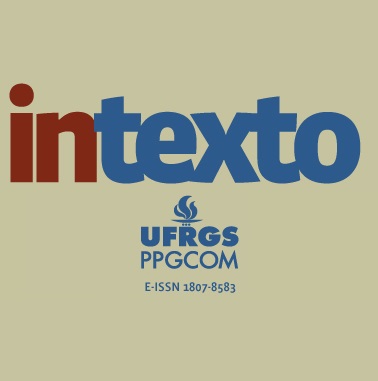TV Journalism: strategies for reconfiguring the same news
DOI:
https://doi.org/10.19132/1807-8583202049.196-213Keywords:
Semiotics. TV journalism. Repetition of news.Abstract
Throughout the day, different TV news programs from TV Globo broadcast news about the same events insistently and exhaustively. Basically, for an assiduous audience, this repetition of subjects all day long may have its need questioned and become quite tiresome. Thus, this paper proposes to examine the process of reconfiguring news about the same events, transmitted in five TV newscasts of the TV Globo during 24 hours. It is interesting, in particular, to analyze the mode of operation of the discursive devices of thematization, figurativization, actoralization, spatialization, timing and toning in the process of framing the news in two different events transmitted in five TV newscasts of TV Globo – Bom Dia Brasil, Jornal Hoje, Jornal Nacional and Jornal da Globo – in a 24-hour period, verifying in particular the manipulation of discursive devices with the purpose to check the sense of actuality of the subjects conveyed repeatedly on TV. The theory-methodology organization substantiates a discursive semiotics inspired by European Semiotics principles based on Saussere (2012), Hjelmslev (2013), and Greimas and Courtés (2016), as well as other researchers whose studies are about the televisual production. The results obtained in this investigation reveal the existence of at least three processes of reconfiguration of the discursive elements in the conformation of news about the same events: (1) the complexification of the discursive devices; (2) stabilization of the discursive devices and (3) reprise / re-presentation of the same discursive conformations.
Downloads
References
BACKES, V. C. Telejornalismo: diferentes reconfigurações da notícia. 2018. 203 f. Dissertação (mestrado em Comunicação Midiática) - Programa de Pós Graduação em Comunicação, Universidade Federal de Santa Maria, Santa Maria, 2018.
BOM DIA BRASIL. Focado no noticiário político e econômico, com entrevistas e análises de comentaristas. Memória Globo. [s.l.], c2013. Disponível em: http://memoriaglobo.globo.com/programas/jornalismo/telejornais/bom-dia-brasil.htm# Acesso em 06 maio 2018.
CALABRESE, O. A idade neobarroca. Lisboa: Edições 70, 1987.
DUARTE, E. B. Telejornais: dos tons referentes ao subgênero e formato àquele próprio da produção local. In: SILVEIRA, A. C. M.; BARICHELLO, E. M. R.; FOSSÁ, M. I. T.; LISBOA FILHO, F.. (org.). Identidades midiáticas. Santa Maria: FACOS-UFSM, 2012, p. 57-81.
DUARTE, E. B. Telejornais: incidências do tempo sobre o tom. In: Duarte, E. B.; CASTRO, M. L. D. de (org). Comunicação audiovisual: gêneros e formatos. Porto Alegre: Sulina, 2007.
DUARTE, E. B.; CASTRO, M. L. D. de. Produção midiática: o ir e vir entre teoria, metodologia e análise. In: BARICHELLO, E. M. M. R; RUBLESCKI, A. S. Pesquisa em comunicação: olhares e abordagens. Santa Maria: FACOS-UFSM, 2014, p. 67-87.
FECHINE, Y. Televisão e Presença: semiótica da transmissão direta. São Paulo: Estação de Letras e Cores, 2008.
GREIMAS, A. J.; COURTÉS, J. Dicionário de semiótica. 2. ed.. São Paulo: Contexto, 2016.
HJELMSLEV, L. Prolegômenos a uma teoria da linguagem. São Paulo: Perspectiva, 2013.
HORA UM. Com uma linguagem leve e informal, o telejornal informa as primeiras notícias do Brasil e do mundo para um público que acorda cedo. Memória Globo. [s.l.], c2013. Disponível em: http://memoriaglobo.globo.com/programas/jornalismo/telejornais-e-programas/hora-um-da-noticia.htm. Acesso em 06 maio 2018.
JORNAL DA GLOBO. O Jornal da Globo traz para os espectadores as notícias da noites e também análises, críticas e opiniões sobre os principais assuntos do dia. Memória Globo. [s.l.], c2013. Disponível em: http://memoriaglobo.globo.com/programas/jornalismo/telejornais/jornal-da-globo-1979-no-ar.htm. Acesso em: 06 maio 2018.
JORNAL HOJE. Culinária, arte, comportamento, moda, cidadania, defesa do consumidor e diversos outros assuntos fazem parte do noticiário, apresentado com uma linguagem leve e informal. Memória Globo. [s.l.], c2013. Disponível em: http://memoriaglobo.globo.com/programas/jornalismo/telejornais/jornal-hoje.htm. Acesso em: 06 maio 2018.
JORNAL NACIONAL. Primeiro telejornal do Brasil a ser transmitido em rede, o JN conquistou a preferência do público e se firmou como um dos mais respeitáveis do país. Memória Globo. [s.l.], c2013. Disponível em: http://memoriaglobo.globo.com/programas/jornalismo/telejornais/jornal-nacional.htm. Acesso em: 06 maio 2018.
JOST, F. Seis lições sobre televisão. Porto Alegre: Sulina, 2004.
MARCONDES FILHO, C. Ser jornalista: a língua como barbárie e a notícia como mercadoria. São Paulo: Paulus, 2009.
REZENDE, G. J. de. 60 anos de jornalismo na TV brasileira: percalços e conquistas. In: VIZEU, A.; PORCELLO, F.; COUTINHO, I. (org.). 60 anos de telejornalismo no Brasil: História, análise e crítica. Florianópolis: Insular, 2010.
SAUSSURE, F. de. Curso de linguística geral. São Paulo: Cultrix, 2012.
SECRETARIA ESPECIAL DE COMUNICAÇÃO SOCIAL (Brasil). Pesquisa Brasileira de Mídia 2016: relatório final. Brasília: Ibope, 2016. Disponível em: http://www.secom.gov.br/atuacao/pesquisa/lista-de-pesquisas-quantitativas-e-qualitativas-de-contratos-atuais/pesquisa-brasileira-de-midia-pbm-2016.pdf/view. Acesso em: 20 maio 2017.
SILVA, G. Para pensar critérios de noticiabilidade. In: SILVA, G.; SILVA, M. P. da; FERNANDES, M. L. (org.). Critérios de noticiabilidade: problemas conceituais e aplicações. Florianópolis: Editora Insular, 2014.
Downloads
Published
How to Cite
Issue
Section
License
Copyright (c) 2020 Intexto

This work is licensed under a Creative Commons Attribution-NonCommercial 4.0 International License.
The copyright of works published in this journal belong to the authors, and the right of first publication is conceded to the journal. Due to the journal being of open access, the articles are of free use in research, educational and non-commercial activities.
Therefore, the journal uses the License Creative Commons Attribution (CC BY-NC 4.0), which allows sharing of work with acknowledgment of authorship.
Self-archiving (repository policy): authors are allowed to deposit all versions of their work in institutional or thematic repositories without embargo. It is requested, whenever possible, that the full bibliographic reference of the version published in Intexto (including the DOI link) be added to the archived text.
Intexto does not charge any article processing fees (article processing charge).















